Abstract
1 Two mechanisms have been proposed to explain the decline in brain tryptophan and 5-hydroxytryptamine (5-HT) after administration of hydrocortisone and the subsequent induction of liver pyrrolase. These are depletion of tryptophan by high rates of tryptophan catabolism and inhibition of tryptophan uptake by elevated levels of the tryptophan catabolite, kynurenine.
2 The increase in plasma kynurenine after hydrocortisone injection (25 mg/kg) was small, and kynurenine, at a concentration ten fold greater, did not inhibit tryptophan uptake by brain as measured by the Oldendorf technique. Thus, inhibition of tryptophan uptake by kynurenine is not an important mechanism in the control of brain tryptophan and 5-HT.
3 The decline in brain tryptophan after hydrocortisone was comparable to that seen in other tissues, which comprise more than half of the body weight of a rat.
4 The total decline in free tryptophan stores in whole animals treated with hydrocortisone was estimated to be about 450 μg. This amount of tryptophan would be catabolized by tryptophan pyrrolase in about 20 min, when the enzyme is induced, according to an earlier estimate of the rate of tryptophan catabolism in vivo.
5 Tryptophan pyrrolase activity remains high for much longer than 20 min, suggesting that there is net protein catabolism, which releases tryptophan and prevents non-protein tryptophan levels falling very far.
6 These results demonstrate that the decline in brain tryptophan and 5-HT after hydrocortisone is caused by depletion of tryptophan stores due to the high activity of tryptophan pyrrolase. However, our data suggest that this effect is diminished by release of tryptophan from proteins. Thus, peripheral protein metabolism may be an important factor in the control of brain tryptophan levels and 5-HT synthesis.
Full text
PDF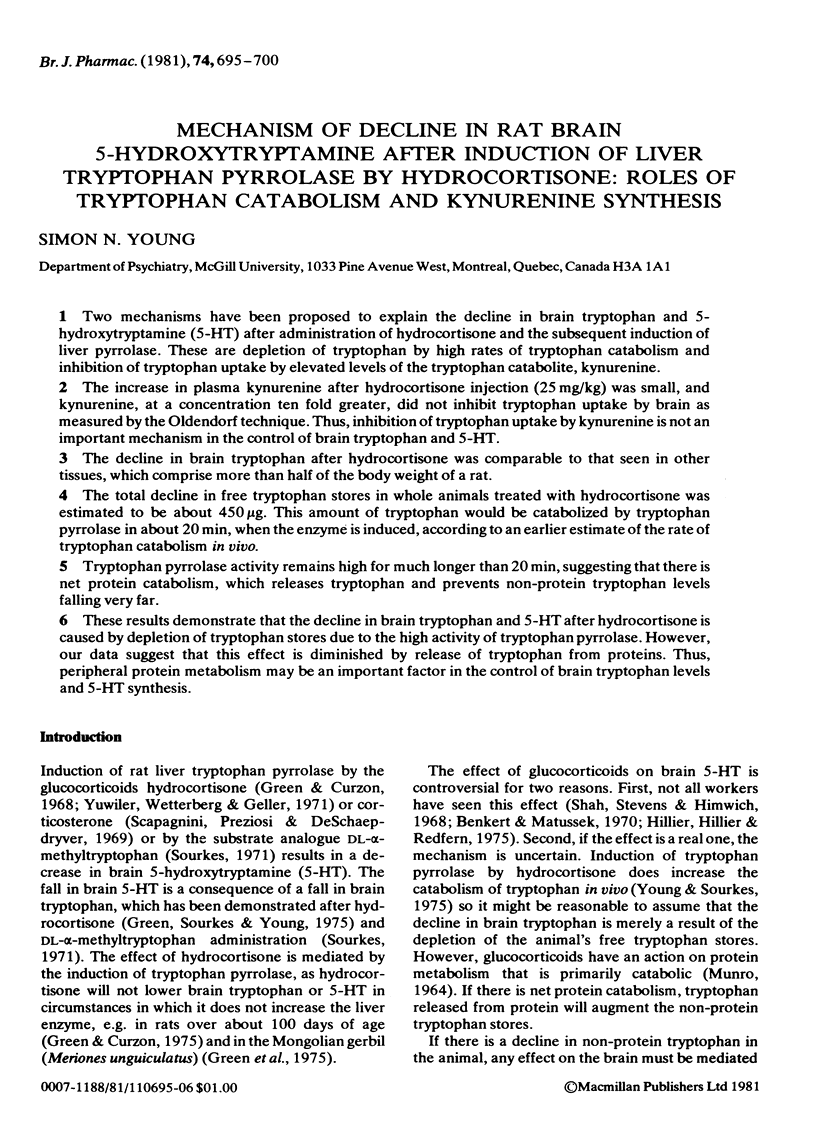
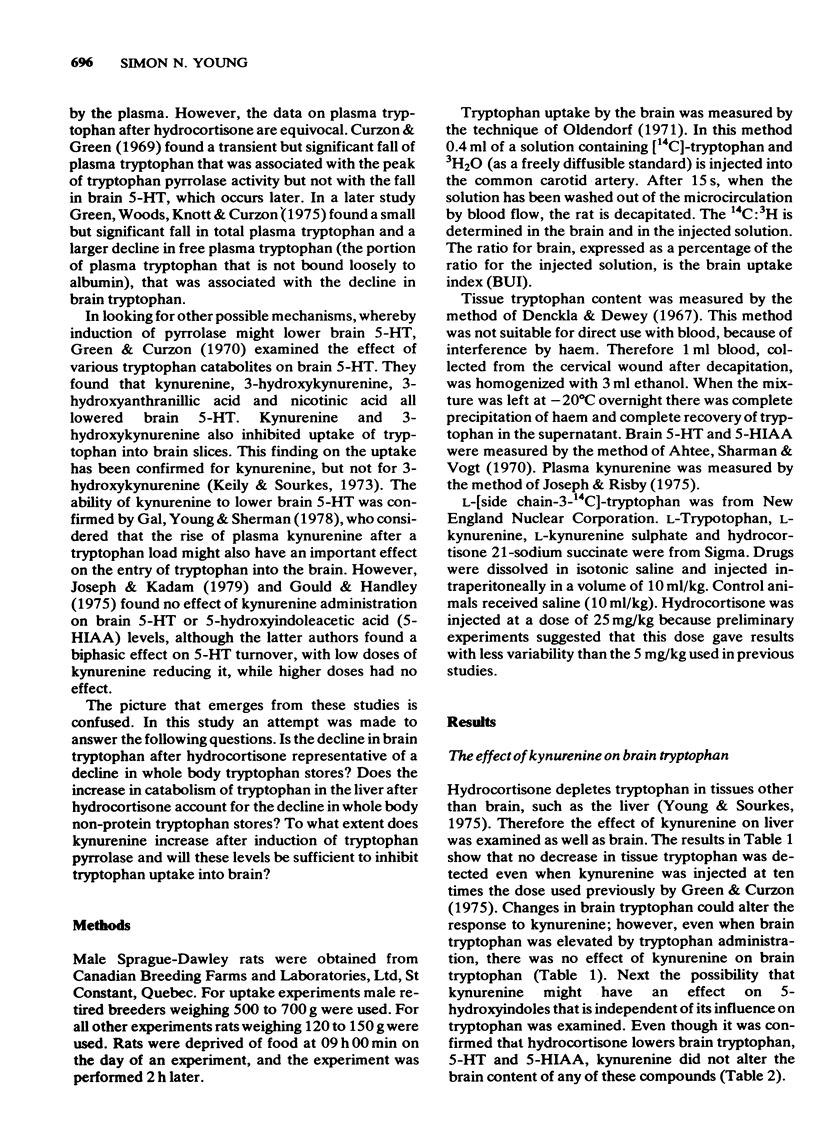
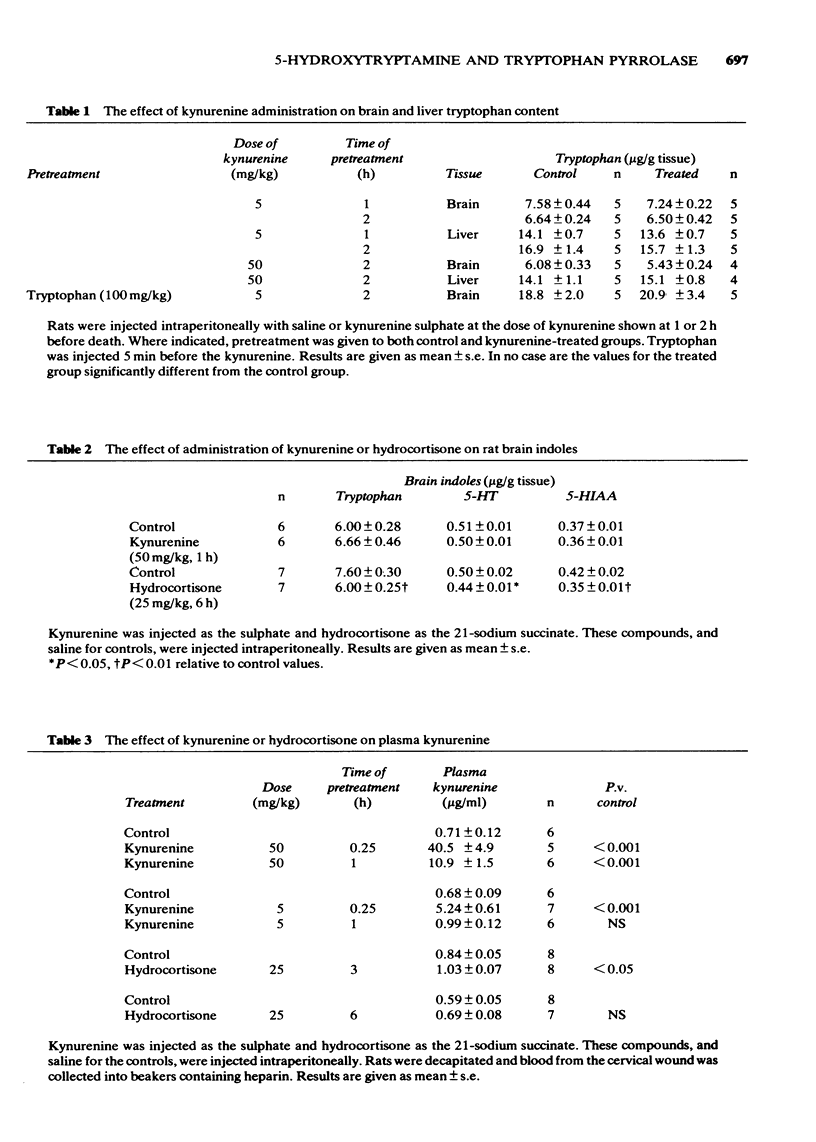
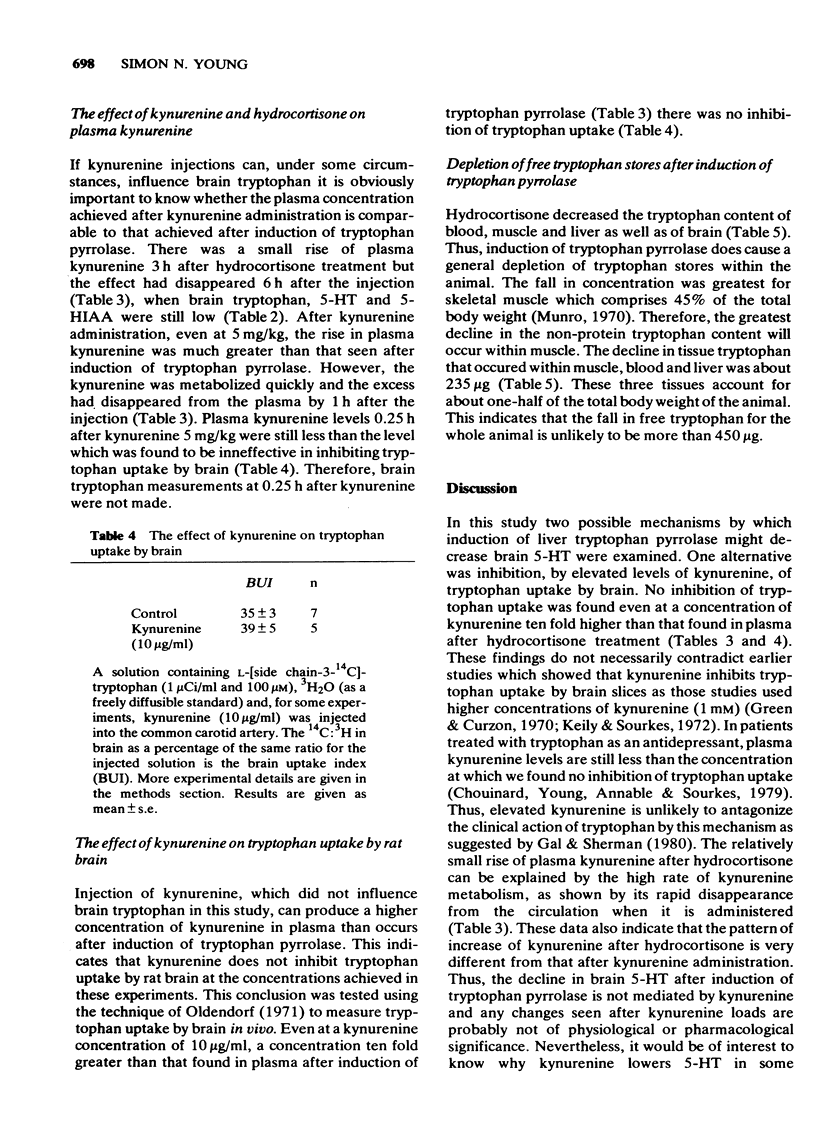
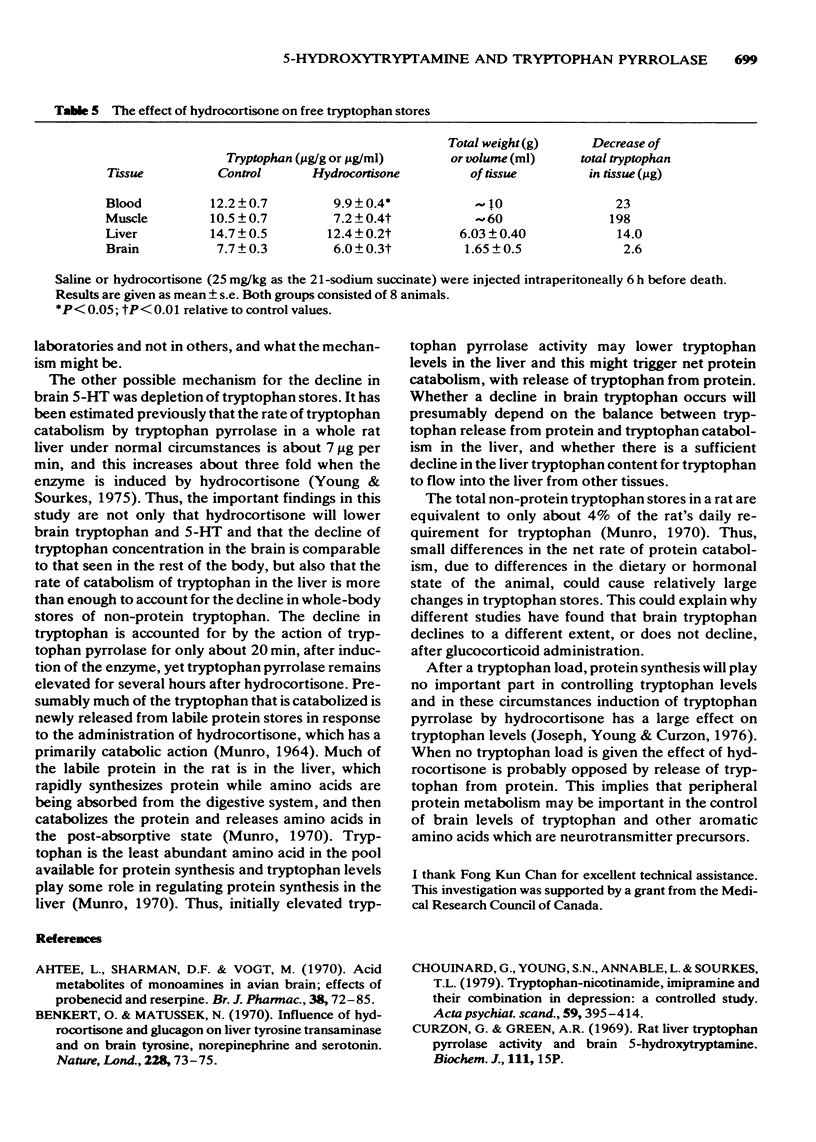
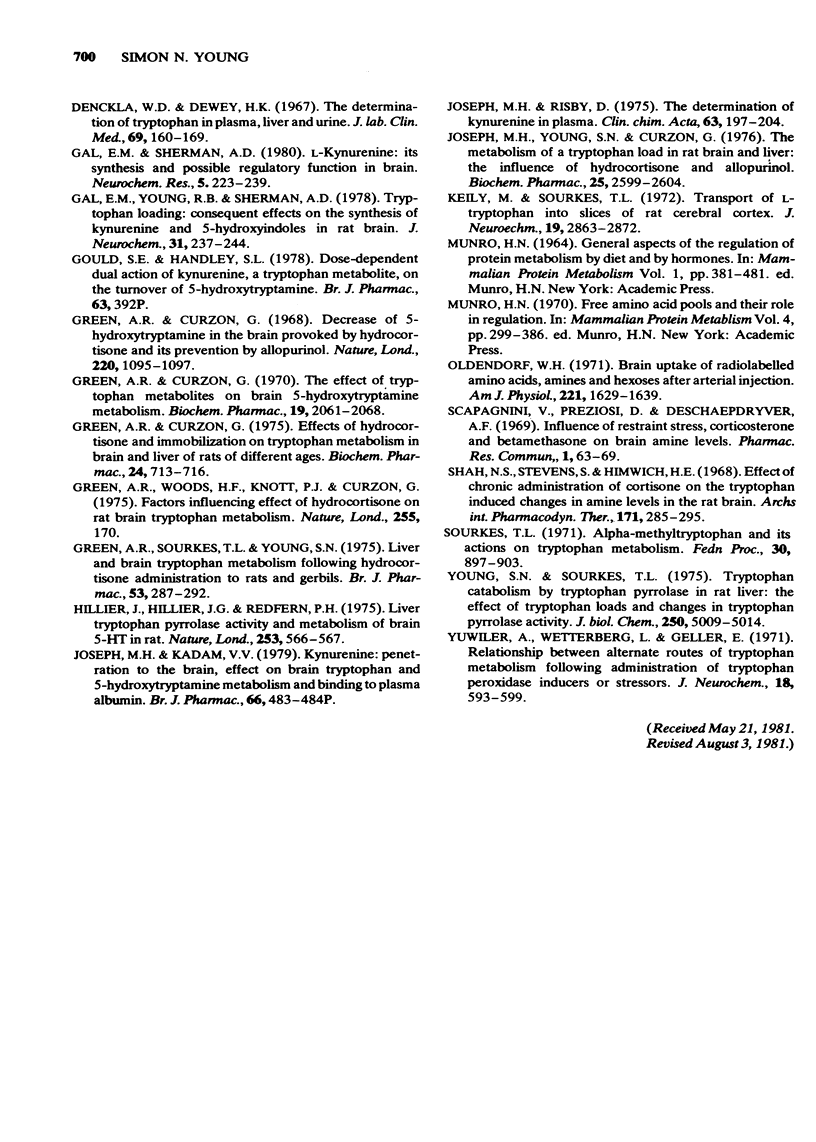
Selected References
These references are in PubMed. This may not be the complete list of references from this article.
- Ahtee L., Sharman D. F., Vogt M. Acid metabolites of monoamines in avian brain; effects of probenecid and reserpine. Br J Pharmacol. 1970 Jan;38(1):72–85. doi: 10.1111/j.1476-5381.1970.tb10337.x. [DOI] [PMC free article] [PubMed] [Google Scholar]
- Benkert O., Matussek N. Influence of hydrocoritsone and glucagon on liver tyrosine transaminase and on brain tyrosine, norepinephrine and serotonin. Nature. 1970 Oct 3;228(5266):73–75. doi: 10.1038/228073a0. [DOI] [PubMed] [Google Scholar]
- Chouinard G., Young S. N., Annable L., Sourkes T. L. Tryptophan-nicotinamide, imipramine and their combination in depression. A controlled study. Acta Psychiatr Scand. 1979 Apr;59(4):395–414. doi: 10.1111/j.1600-0447.1979.tb04482.x. [DOI] [PubMed] [Google Scholar]
- Curzon G., Green A. R. Rat liver tryptophan pyrrolase activity and brain 5-hydroxytryptamine. Biochem J. 1969 Feb;111(3):15P–15P. doi: 10.1042/bj1110015pa. [DOI] [PMC free article] [PubMed] [Google Scholar]
- Denckla W. D., Dewey H. K. The determination of tryptophan in plasma, liver, and urine. J Lab Clin Med. 1967 Jan;69(1):160–169. [PubMed] [Google Scholar]
- Gould S. E., Handley S. L. Dose-dependent dual action of kynurenine, a tryptophan metabolite, on the turnover of 5-hydroxytryptamine [proceedings]. Br J Pharmacol. 1978 Jun;63(2):392P–392P. [PMC free article] [PubMed] [Google Scholar]
- Green A. R., Curzon G. Decrease of 5-hydroxytryptamine in the brain provoked by hydrocortisone and its prevention by allopurinol. Nature. 1968 Dec 14;220(5172):1095–1097. doi: 10.1038/2201095a0. [DOI] [PubMed] [Google Scholar]
- Green A. R., Curzon G. Effects of hydrocortisone and immobilization on tryptophan metabolism in brain and liver of rats of different ages. Biochem Pharmacol. 1975 Mar 15;24(6):713–716. doi: 10.1016/0006-2952(75)90248-8. [DOI] [PubMed] [Google Scholar]
- Green A. R., Curzon G. The effect of tryptophan metabolites on brain 5-hydroxytryptamine metabolism. Biochem Pharmacol. 1970 Jun;19(6):2061–2068. doi: 10.1016/0006-2952(70)90303-5. [DOI] [PubMed] [Google Scholar]
- Green A. R., Sourkes T. L., Young S. N. Liver and brain tryptophan metabolism following hydrocortisone administration to rats and gerbils. Br J Pharmacol. 1975 Feb;53(2):287–292. doi: 10.1111/j.1476-5381.1975.tb07360.x. [DOI] [PMC free article] [PubMed] [Google Scholar]
- Green A. R., Woods H. F., Knott P. G., Curzon G. Letter: Factors influencing effect of hydrocortisone on rat brain tryptophan metabolism. Nature. 1975 May 8;255(5504):170–170. doi: 10.1038/255170a0. [DOI] [PubMed] [Google Scholar]
- Gál E. M., Sherman A. D. L-kynurenine: its synthesis and possible regulatory function in brain. Neurochem Res. 1980 Mar;5(3):223–239. doi: 10.1007/BF00964611. [DOI] [PubMed] [Google Scholar]
- Gál E. M., Young R. B., Sherman A. D. Tryptophan loading: consequent effects on the synthesis of kynurenine and 5-hydroxyindoles in rat brain. J Neurochem. 1978 Jul;31(1):237–244. doi: 10.1111/j.1471-4159.1978.tb12454.x. [DOI] [PubMed] [Google Scholar]
- Hillier J., Hillier J. G., Redfern P. H. Liver tryptophan pyrrolase activity and metabolism of brain 5-HT in rat. Nature. 1975 Feb 13;253(5492):566–567. doi: 10.1038/253566a0. [DOI] [PubMed] [Google Scholar]
- Joseph M. H., Kadam B. V. Kynurenine: penetration to the brain, effect on brain tryptophan and 5-hydroxytryptamine metabolism and binding to plasma albumin [proceedings]. Br J Pharmacol. 1979 Jul;66(3):483P–484P. [PMC free article] [PubMed] [Google Scholar]
- Joseph M. H., Risby D. The determination of kynurenine in plasma. Clin Chim Acta. 1975 Sep 1;63(2):197–204. doi: 10.1016/0009-8981(75)90163-1. [DOI] [PubMed] [Google Scholar]
- Joseph M. H., Young S. N., Curzon G. The metabolism of a tryptophan load in rat brain and liver. The influence of hydrocortisone and allopurinol. Biochem Pharmacol. 1976 Dec 1;25(23):2599–2604. doi: 10.1016/0006-2952(76)90515-3. [DOI] [PubMed] [Google Scholar]
- Kiely M., Sourkes T. L. Transport of L-tryptophan into slices of rat cerebral cortex. J Neurochem. 1972 Dec;19(12):2863–2872. doi: 10.1111/j.1471-4159.1972.tb03824.x. [DOI] [PubMed] [Google Scholar]
- Oldendorf W. H. Brain uptake of radiolabeled amino acids, amines, and hexoses after arterial injection. Am J Physiol. 1971 Dec;221(6):1629–1639. doi: 10.1152/ajplegacy.1971.221.6.1629. [DOI] [PubMed] [Google Scholar]
- Shah N. S., Stevens S., Himwich H. E. Effect of chronic administration of cortisone on the tryptophan induced changes in amine levels in the rat brain. Arch Int Pharmacodyn Ther. 1968 Feb;171(2):285–295. [PubMed] [Google Scholar]
- Sourkes T. L. Alpha-methyltryptophan and its actions on tryptophan metabolism. Fed Proc. 1971 May-Jun;30(3):897–903. [PubMed] [Google Scholar]
- Young S. N., Sourkes T. L. Tryptophan catabolism by tryptophan pyrrolase in rat liver. The effect of tryptophan loads and changes in tryptophan pyrrolase activity. J Biol Chem. 1975 Jul 10;250(13):5009–5014. [PubMed] [Google Scholar]
- Yuwiler A., Wetterberg L., Geller E. Relationship between alternate routes of tryptophan metabolism following administration of tryptophan peroxidase inducers or stressors. J Neurochem. 1971 Apr;18(4):593–599. doi: 10.1111/j.1471-4159.1971.tb11989.x. [DOI] [PubMed] [Google Scholar]


